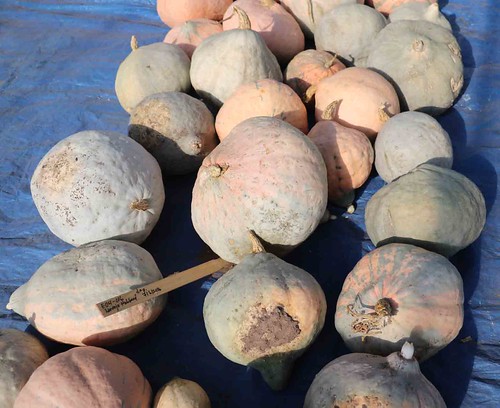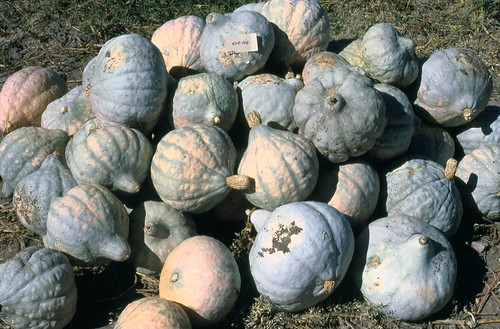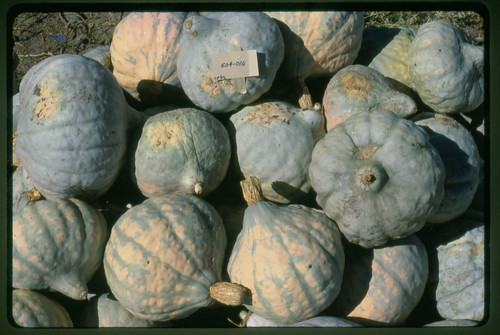ADAPTS
the Adaptive Drylands Agriculture Portal for The Southwest
E04-016
Collection | Availability | Map | Climate | Photographs | Observations | Cultivation & Seed Saving | Feedback
Basic Collection Information and Status
Squash (Cucurbita maxima, Cucurbitaceae)
Cultural Affiliation NavajoCollection Site New Mexico, United States (latitude: 37°; altitude: 4,900 ft / 1,500 m)
Collection Year 1981
Accession Status Active
Catalog Information and Instructions
Navajo HubbardEX005
Large fruits with green-blue, dark green, light pink, or orange skin and tasty orange flesh. Shapes are round with pointed ends and occasional elongated fruits. A common Hubbard across the Navajo Nation.
View All 5 Accessions of Navajo Hubbard (EX005) (this will reset your search)
View All 5 Accessions of Navajo Hubbard (EX005) (this will reset your search)
Current availability of this variety is summarized below. We encourage the use of these seeds to benefit humanity and strive to facilitate access through a number of channels.
Seeds of this variety are not currently available for distribution. If you are interested in this accession for research, seed increase, or repatriation purposes, please contact us.Collection Site
The circle in the map below shows the area where this accession was collected (why isn't the precise locality shown
?Precise collection localities are hidden in order to protect the privacy of the original donors of the seeds in the NS/S collection.
). You have not specified a reference site, but you may specify one and rerun your search.The graphs below summarize aspects of the climate for this accession's collection site. You have not specified a reference site, but you may specify one and rerun your search.
Photographs
The Native Seeds/SEARCH digital photo collection for this accession is provided below.
image hosting provided by Flickr — all photos © Native Seeds/SEARCH — please contact us for permission to useCharacterization and Evaluation
The table below lists observations of this accession's characteristics (why are characters sometimes listed more than once
?For some accessions, observations of a particular trait have been recorded over more than one season or location; these are indicated by the different values in the Lot column.
).| Character | Observation | Lot, Frequency and Comments | Character Description (Source and Code) |
|---|---|---|---|
| blossom-end fruit shape | Pointed with nipple | lot: CF '02 | (Bioversity 6.2.6: 7 w/nipple) |
| days to 50% flower | 70 DAP | lot: CF '02 | |
| days to first flower | 67 DAP | lot: CF '02 | |
| fruit shape | Elliptical (oval) | lot: CF '02 | (Bioversity 4.2.3: 5*) |
| habit | Prostrate | lot: CF '02 | (Bioversity 4.1.1: 7) |
| leaf hairs | Both sides | lot: CF '02 | (Bioversity 6.1.11/6.1.12: both sides) |
| leaf lobes | Shallow | lot: CF '02 | (Bioversity 6.1.10: 3) |
| leaf margin | Dented | lot: CF '02 | (Bioversity 6.1.9: 2) |
| leaf spots | Absent | lot: CF '02 | (Bioversity 6.1.8: 0) |
| note | *-a deeply lobed leaf shows up now and again | lot: CF '02 | |
| peduncle | Corky | lot: CF '02 | (Bioversity 4.2.2) |
| ribs | Superficial | lot: CF '02 | (Bioversity 4.2.4: 3) |
| seed coat color | Brown | lot: CF '02 | (Bioversity 6.3.4: 5) |
| seed margin | Absent | lot: CF '02 | (Bioversity 6.3.5: 0) |
| seed surface | Smooth | lot: CF '02 | (Bioversity 6.3.2: 1) |
| skin color | Greenââ¬âblue with orange | lot: CF '02 | (Bioversity 4.2.5: 2-3 w/orange) |
| skin pattern | Splotchy, striped | lot: CF '02 | (Bioversity 4.2.7: splotchy,stripes) |
| skin texture | Shallow wavy | lot: CF '02 | (Bioversity 4.2.8) |
| tendrils | Present | lot: CF '02 | (Bioversity 6.1.5: *) |
| Squash Introduction | Cultivation Instructions | Seed Saving Instructions |
|---|---|---|
| Flowers, seeds and growing tips of vines are all edible. All fruits can be eaten when small and immature as summer squash, and mature as winter squash. | In spring after soil warms, or with summer rains, sow a few seeds 1" deep in basins 3-6' apart, allowing room for abundant vine growth. Squash likes soil rich in compost. | An insect-pollinated annual, varieties of the same species will cross. Allow fruits to ripen and mature on the vine until skin is hard and stem brown. After harvesting, fruit needs to after-ripen for 30 days in cool location. Remove seeds, wash and dry before storage. |
If you have questions or feedback about this accession or the ADAPTS platform in general, please contact us.








